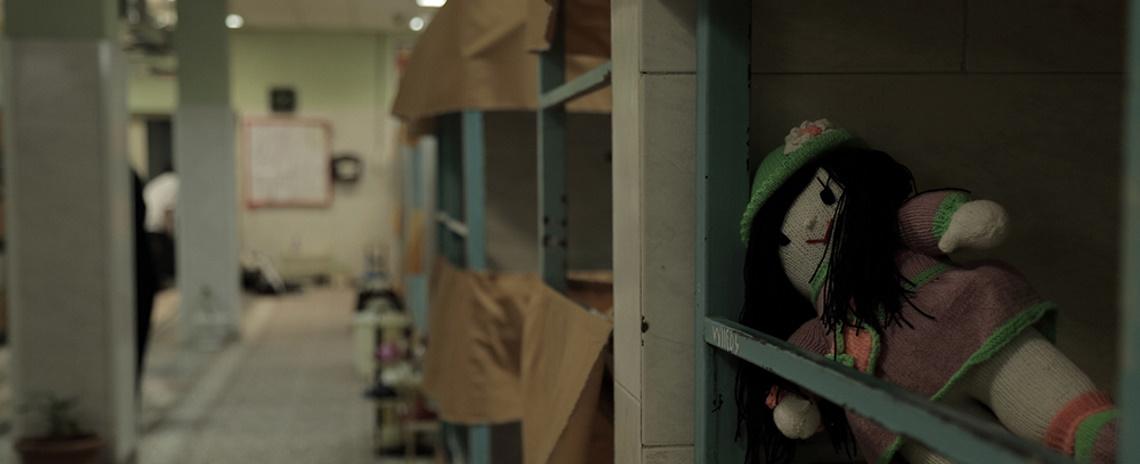One interpretation of the title of Mehdrad Oskouei’s new documentary, Sunless Shadows, is that the evocative alliteration refers to its subjects. The set of imprisoned Iranian teenage women the film follows have faded into the background of society at large, and the cause of their obscured existence may be even further out of sight. Somayeh, Mahsa, Panda, Sara, Elham, and Negar have all been sentenced to time in a juvenille correctional facility in Tehran for a common crime: the murder of men in their lives, commonly their fathers or, in one case, a teenage husband.
Oskouei’s latest feature is the fourth in a series – Shadows was preceded by It’s Always Late for Freedom (2007), The Last Days of Winter (2011), Starless Dreams (2016) – that follows locked-up younger men and women in Iran. Like those films, the urgent, provocative, and ultimately life-affirming Shadows is compact, running only 74 minutes, and concise in its aesthetic ambition. It’s a small film that nevertheless presents a microcosm of a culture rife with toxic masculinity, cycles of emotional and physical violence, and denigrated women – the participants in that society who suffer most.
Sunless Shadows essentially presents two types of scenes: confessional and behavioral. The former type presents another possible meaning for the film’s title, a metaphor for past traumatic experiences whose mark is unerasable. It would not be appropriate to summarize the prisoners’ stories in this review. Attempting to distill them without the speakers’ firsthand accounts would unduly simplify morally complex matters and rob the subjects of their due process. Oskouei graciously allows for the latter throughout, presenting each of his participants in direct address either to an imprisoned family member – their mothers or sisters, who are also culpable for their crimes – or to their deceased victims themselves.
With the women staring directly into the camera’s eye, and therefore the viewer’s, the setup is similar to Errol Morris’ Interrotron camera (see the director’s Fog of War [2004] for an example of its use). However, Oskouei’s use of the device here seems to be more about inducing empathy than the search for “truth” in subjectivity that characterizes Morris’ work. Nevertheless, the device gently pushes a film that could have used simple observation toward the dizzyingly undefinable non-narrative work of internationally well-known Iranian directors like Abbas Kiarostami (Close-Up [1990]) and Jafar Panahi (This is Not a Film [2011]).
Within these confessionals or outside of them, the filmmaker places no judgment, allowing the viewer to parse the details of each subject’s story and question any knee-jerk reactions they might have. Would I have done the same in her shoes? In a late scene, the women discuss these quandaries with each other. Seated on the ground between their iron bunk beds, at first they seem to be playing the roles of an indicting public or the Iranian court informed by the tenets of the Koran, proposing methods alternative to murder for escape of their abusive situations. Their passion reveals that their opinions are not role-play but personal judgment of the specific situations that prompted each of them to commit murder. If not for the already apparent sisterly bond they have for each other, the conversation might play as a circle of moral finger-wagging. Instead, their statements come across as pleas to somehow change the past, as if to relieve them of their heavy burdens.
As the tension rises here, the teens eventually turn to the camera and address the director as “Uncle Mehdrad,” begging for agreement with their individual moral arguments. With this, Oskouei’s personal closeness to his subjects is made clear. Yet because of the already-established empathy and admittedly polemical reasons behind telling Sunless Shadows, his direct involvement with his subjects doesn’t raise the usual questions about the act of observation and the participation of the documentary filmmaker changing what’s documented.
Oskouei does have explicit stakes in the game. In interviews, the director has revealed his motivation behind giving visibility to these forgotten lives. As a 15-year-old, he attempted suicide, which he says makes him feel like both a murderer and a victim. That fact is not mentioned in Shadows, but his past does reveal why he takes great pains to show that the prisoners are not exclusively their crimes. As depicted here, these women live together as a community bound together by common experience. They celebrate milestones, work hand-in-hand daily, and provide constant emotional and practical support. Without these small yet lovely depictions of sisterhood, the film could have been a very dour hour-and-change, but because Oskouei takes great pains to illuminate these figures as human beings, first and foremost, Sunless Shadows is a tribute to perseverance in the face of great adversity.
Rating: B
Sunless Shadows is now available to rent online through the Cinema Guild. Purchase a virtual ticket from Aug. 7 - 20 and the proceeds will support the Webster University Film Series.


